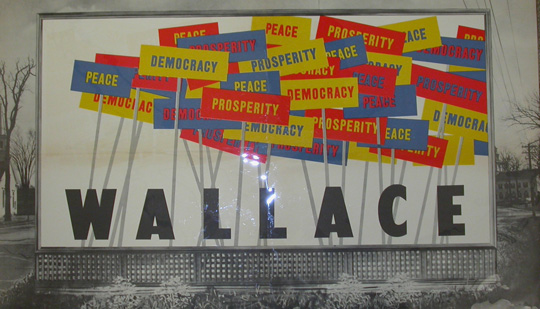
When the Democratic Party convenes in Philadelphia on July 25, it will be meeting in a city known not only for its pivotal role in the founding of this country, but also for its long tradition of political conventions. Nine times previously political parties have held their nominating meetings in the city. None was more meaningful for today, though, than that of the Progressive Party in 1948.
The Progressive Party arose out of increasing opposition to the growing tensions of the Cold War. Many people felt betrayed that peaceful relations between the United States and the Soviet Union, which Franklin D. Roosevelt worked so hard to achieve, had deteriorated badly in such a short time. President Harry S. Truman was the public face of those forces, including the nascent military-industrial complex and the racists and segregationists who dominated the Democratic Party – those who sought to blunt the will of the people. The twin evils of militarism (rationalized by a so-called “communist threat”) and racism dominated the political discourse.
Truman had instituted “loyalty oaths,” and the House Committee on Un-American Activities (HUAC) had held hearings designed to uncover “subversives” in various areas of American life. The best-known were those of the “Hollywood Ten” – prominent screenwriters and directors who were denied work because of “pro-communist” sympathies.
With the so-called Truman Doctrine, the United States declared its foreign policy aim was to “contain communism.” Some, like radical-turned-conservative James Burnham, even wanted to go further and favored “rolling it back.” The budget of the newly-created Defense Department, which (under its predecessor, the War Department) had been $1.9 billion in 1939, jumped to $52 billion in 1947, then nearly doubled the next year to over $100 billion. It would grow by an additional 40 percent in 1949.
Opposing the emerging Cold War
Many Americans were not buying these goods. After the hostilities of World War II concluded in 1945, there had been a general desire to build real world peace and to carry on the ideals of the New Deal begun by President Roosevelt. A diverse group that included labor unions, particularly those in the Congress of Industrial Organizations (CIO), women, youth, people of color, and intellectuals sought to short-circuit the dangerous trends in our society.
Henry A. Wallace, a former vice-president of the United States and Cabinet member, assumed the leadership of this movement. Because the political conditions of the emerging Cold War in 1948 barred any meaningful role for him in either of the two major parties, Wallace and his supporters decided to build an independent movement. Thus, the Progressive Party was born.
Its members convened in Philadelphia the third week of July for a meeting like few others in American history. One scholar called it “an astonishing affair by all accounts.” Most of the delegates were “plain people with little practical political experience.” Howard Smith, writing in The Nation that summer, reported that there were “hundreds who hitch-hiked” to get there, with many of them staying in tents in the convention hall parking lot.
The delegates nominated Wallace for president and adopted a platform that offered a different political agenda for the country. In areas of economics, social justice, human rights, and peace it laid down principles that went directly counter to the emerging Cold War under Truman.
A platform for peace and justice
In the preamble to its platform, the party warned that the “American way of life is in danger.” The root cause of this crisis, it argued, “is Big Business control of our economy and Government.” In words eerily similar to the present, it noted that, “Never before have so few owned so much at the expense of so many.” As such, “The Progressive Party is born in the deep conviction that the national wealth and natural resources of our country belong to the people who inhabit it and must be employed in their behalf; that freedom and opportunity must be secured equally to all; that the brotherhood of man can be achieved and scourge of war ended.”
The Progressives wanted a government that acted in the interests of the common people and which believed “it is the first duty of a just government to secure for all the people, regardless of race, creed, color, sex, national background, political belief, or station in life, the inalienable rights proclaimed in the Declaration of Independence and guaranteed by the Bill of Rights.” They thought the government “must actively protect these rights against the encroachments of public and private agencies.” Their platform demanded an end to discrimination “in all its forms and in all places.” And that was not to be only a symbolic gesture, but something that would be achieved through “special programs to raise the low standards of health, housing, and educational facilities” for African-Americans, Native Americans, and all people.
Hand-in-hand with the struggle for social justice and human rights, the Progressives acknowledged that the labor movement “remains the mainspring of America’s democratic striving, and must be given every opportunity to continue the struggle” so that “every American who works for a living has an inalienable right to an income sufficient to provide him and his family with a high standard of living.” This included the “extension of social security protection to every man, woman, and child in the United States.” The Platform went on to say that, “Unless the rights of labor to organize, to bargain collectively, and to strike are secure, a rising standard of living cannot be realized.”
In the area of foreign affairs, the Progressive Party proclaimed that “only through peaceful understanding can the world make progress toward…higher standards of living; that peace is the essential condition for safe-guarding and extending our traditional freedoms.” The platform underscored that view by declaring “we believe that people everywhere in the world have the right to self-determination,” and that the people of Puerto Rico “have the right to independence.”
Reaction killed the Progressive dream
After the convention adjourned, activists spread out across the country. They received much enthusiasm and solid support during the campaign. Early polls gave Wallace 20 percent of the vote. But over the next few months, Wallace fell victim to the rising “anti-communist” crusade that affected every corner of progressive people’s lives. Smeared as a “tool” of the Communist Party, by election day his support almost completely melted away. In the end, he received only 1.1 million votes (less than 2 1/2 percent of all ballots cast). He carried no states.
In the years that followed, the progressive movement confronted a massive onslaught of persecution, prosecution, and repression. Joseph McCarthy, an obscure Republican Senator from Wisconsin, came to dominate the public arena with unfounded charges that led to a crippling of the progressive movement. It would take years for it to recover, and in some ways we still live with that legacy. Even Henry Wallace would move to the political center by the 1950s.
Many of the goals of the Progressive Party, therefore, remain unfilled to this day. Rising anger against the decline in working class living standards has reached its greatest level in the 2016 election. Progressives, such as the Bernie Sanders delegates to the Democratic National Convention, need to continue the fight against economic inequality, racial injustice, political corruption, and climate change. If successful, they might just bring to fruition the work of the Progressive Party in Philadelphia nearly seventy years ago.
Photo: A billboard for the Progressive Party’s 1948 candidate for president, Henry A. Wallace. | University of Iowa Library










